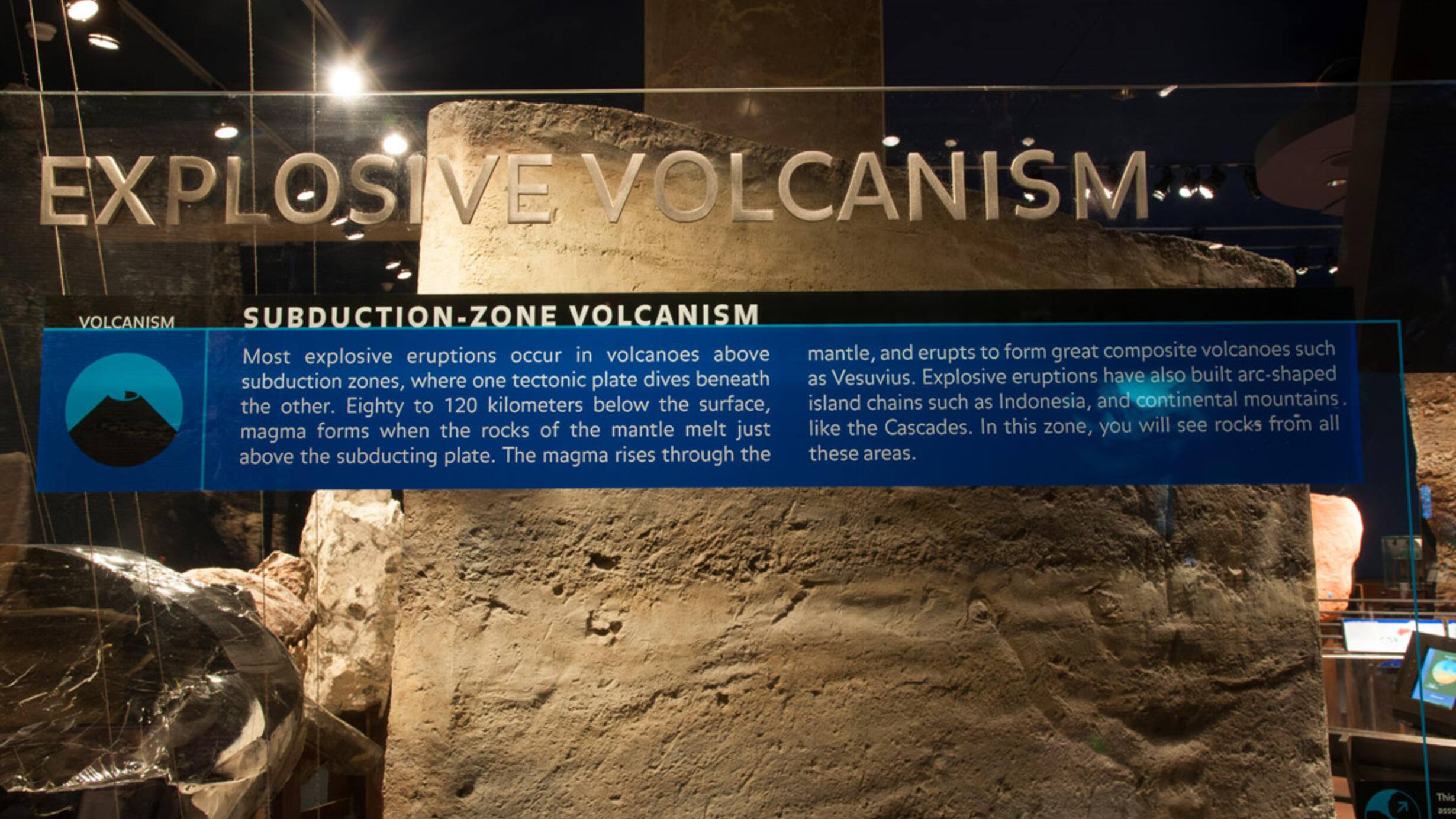Explosive volcanism
Part of Hall of Planet Earth.
 AMNH/R.Mickens
AMNH/R.Mickens
Subduction Zone Volcanism
Most explosive eruptions occur in volcanoes above subduction zones, where one tectonic plate dives beneath the other. Eighty to 120 kilometers below the surface, magma forms when the rocks of the mantle melt just above the subducting plate. The magma rises through the mantle, and erupts to form great composite volcanoes such as Vesuvius. Explosive eruptions have also built arc-shaped island chains such as Indonesia, and continental mountains like the Cascades. In this zone, you will see rocks from all these areas.
Why some volcanoes explode
A volcano’s explosiveness depends on the composition of the magma (molten rock) and how readily gas can escape from it. As magma rises and pressure is released, gas bubbles (mainly of water vapor and carbon dioxide) form and expand rapidly, causing explosions. Magmas with high silica content tend to erupt violently, because they are viscous. They form volcanoes like Krakatau and Tambora in Indonesia, and Mount Rainier and Mount St. Helens in Washington State. In contrast, basaltic magma (which forms the volcanoes of Hawaii and other oceanic islands) contains less silica, is more fluid, and does not erupt in gain explosions.
We are at the edge of the Kawah Ijen crater. Ijen is one of the active volcanoes in Indonesia. Many people live around active volcanoes, because the soil is fertile. And every day there are 100-120 people who mine in Kawah Ijen. The mountain must be monitored for future eruptions. A crater lake like Ijen has chemical characteristics. that can be used to identify volcanic activity.
[Jim Webster] My research involves molten rock, or magma. Most of my work is laboratory based at the American Musuem, but it is important for geologists to go into the field to work with experts like Akhmad and Yustinus. Yustinus and Akhmad are at the cutting edge in terms of predicting volcanic eruptions.
The geologicial mapping of the volcanoes is necessary to predict future eruptions. We can see the deposits produced by the volcanoes. We carefully map the distribution and size of the deposits. From this information, we can create a geological map. Chemical, gas and water data, along with other monitoring data, contributie to determining the level of activity of a volcano. We draw gas samples from the sulfur fumarole, located along the side of a crater lake. The temperature is about 250 degrees Celsius.
[Jim Webster] The major volcanic gaseous compunds influence the physical properties of molten rock, or magma. It's the escape of these volatiles from molten rock that provides the driving force for eruptions, and that's particularly true for explosive volcanic eruptions.
To measure the temperature of the gas, we take measurement in same cavities over a period of time. Water temperature is measured the same way. By collecting these data, we can predict an upcoming eruption.
[Jim Webster] In Indonesia many people reside or work at the base of volcanoes. They have no choice but to live in these areas. There are 129 explosive volcanos in Indonesia. Given the population density of Indonesia and the number of volcanoes, it's important to be able to predict explosive volcanic eruptions in this country. And Akhmad and Yustinus are working to do that.
Scientists at Work: Indonesia
Kawah Ijen volcano, in Indonesia, produces 25 metric tons of sulfur per day. The geologic mapping of volcanoes is necessary to predict future eruptions.
Dr. James Webster from the American Museum of Natural History explores Kawah Ijen crater with scientists from the Volcanological Survey of Indonesia, Dr. Akhmad Zaennudin and Dr. Yustinus Sulistiyo.
This video was produced in 1999 for the David S. and Ruth L. Gottesman Hall of Planet Earth at the American Museum of Natural History.
Video credits:
American Museum of Natural History, James Webster
Ballentyne Brumble Communications
AMNH/R.Mickens
AMNH/R.Mickens
AMNH/R.Mickens
AMNH/R.Mickens
AMNH/R.Mickens